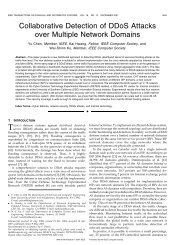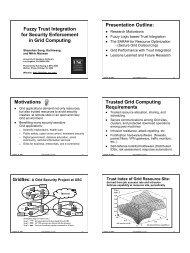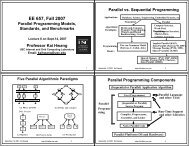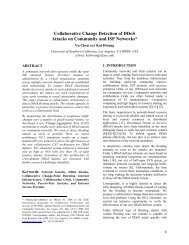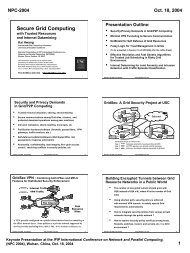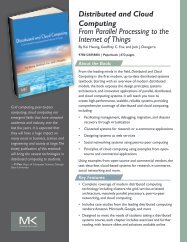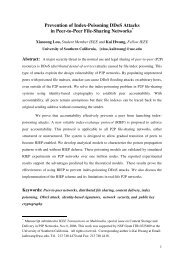Distributed Security Enforcement for Trusted Cluster and Grid ...
Distributed Security Enforcement for Trusted Cluster and Grid ...
Distributed Security Enforcement for Trusted Cluster and Grid ...
You also want an ePaper? Increase the reach of your titles
YUMPU automatically turns print PDFs into web optimized ePapers that Google loves.
<strong>Distributed</strong> <strong>Security</strong><br />
<strong>En<strong>for</strong>cement</strong> <strong>for</strong> <strong>Trusted</strong><br />
<strong>Cluster</strong> <strong>and</strong> <strong>Grid</strong> Computing<br />
Keynote address at the IEEE<br />
International Conference on <strong>Cluster</strong> Computing<br />
(<strong>Cluster</strong> 2003), Hong Kong, Dec. 2, 2003<br />
Kai Hwang<br />
Internet <strong>and</strong> <strong>Grid</strong> Computing Lab<br />
University of Southern Cali<strong>for</strong>nia<br />
Los Angeles, CA. 90089 USA<br />
2/17/2004 1
Presentation Outline:<br />
1. <strong>Distributed</strong> <strong>Grid</strong>Sec Architecture<br />
2. Virtual Private Networks <strong>for</strong> <strong>Distributed</strong><br />
<strong>Security</strong> <strong>En<strong>for</strong>cement</strong><br />
3. Anomaly Intrusion Detection with<br />
Datamining over Network Traffic<br />
4. <strong>Security</strong>-Assured Resource Allocation<br />
5. Wireless Access Control in <strong>Grid</strong> Computing<br />
2/17/2004, Kai Hwang, USC 2
Evolutional Path of<br />
Network-based Computing<br />
Application<br />
to eliminate Resource Isl<strong>and</strong>s<br />
<strong>Grid</strong><br />
grid://…<br />
Application<br />
Web Page<br />
Computer<br />
Web<br />
http://.........<br />
Internet<br />
telnet://.... ,<br />
ftp://.....<br />
Web Page<br />
Computer<br />
Courtesy: Dr. Zhiwei Xu, Chinese Academy of Sciences<br />
2/17/2004, Kai Hwang, USC 3
Trust, <strong>Security</strong>, <strong>and</strong> Privacy<br />
• Trust vs. Risk – The foundation of security <strong>and</strong><br />
privacy in both human society <strong>and</strong> Cyberspace<br />
• <strong>Distributed</strong> Computing <strong>Security</strong> –<br />
More effective with a centralized policy en<strong>for</strong>ced<br />
with a distributed control<br />
• Internet Privacy – Must be protected with<br />
tradeoffs between security constraints <strong>and</strong><br />
privacy dem<strong>and</strong><br />
2/17/2004, Kai Hwang, USC 4
<strong>Security</strong> vs. Scalability<br />
Fully<br />
Secured<br />
Increasing<br />
<strong>Security</strong><br />
No<br />
Protection<br />
A distributed security system supporting<br />
fine-grain resource access with<br />
automatic intrusion prevention,<br />
<strong>Cluster</strong>s/Intranets<br />
detection, <strong>and</strong> responses<br />
protected by gateway based on dynamic security<br />
firewalls under a<br />
policies, adaptive<br />
static policy<br />
cryptographic engines,<br />
Web sites<br />
or LANs<br />
with limited<br />
security<br />
or privacy<br />
protection<br />
with fixed<br />
cryptography<br />
<strong>and</strong> privacy<br />
protection<br />
privacy protection,<br />
<strong>and</strong> special network<br />
security interfaces,<br />
etc.<br />
Web sites/LANs <strong>Cluster</strong>s/Intranets <strong>Grid</strong>s/Internet<br />
Increasing Scalability<br />
2/17/2004, Kai Hwang, USC 5
<strong>Distributed</strong> <strong>Grid</strong>Sec Architecture<br />
Host<br />
Host<br />
3<br />
<strong>Grid</strong><br />
Resource<br />
Domain 1<br />
Host<br />
Host<br />
3<br />
3<br />
Host<br />
3<br />
1<br />
<strong>Grid</strong><br />
Resource<br />
Domain 2<br />
3<br />
3<br />
Host<br />
2<br />
Host<br />
Host<br />
<strong>Security</strong><br />
Manager<br />
3<br />
2<br />
<strong>Grid</strong><br />
Resource<br />
Domain 3<br />
3<br />
3<br />
Host<br />
<strong>Grid</strong><br />
Boundary<br />
Step 1:<br />
Intrusion detected<br />
by a local microfirewall<br />
Step 2:<br />
All security<br />
managers alerted<br />
with the intrusion<br />
Step 3:<br />
<strong>Security</strong> managers<br />
broadcast<br />
response<br />
comm<strong>and</strong> to all<br />
hosts under their<br />
jurisdiction.<br />
(Source: Hwang, et al [1])<br />
2/17/2004, Kai Hwang, USC 6
<strong>Grid</strong>Sec Design Objectives:<br />
• Remove the security barrier hindering distributed grid<br />
computing - Offering a new trust model<br />
• <strong>Grid</strong>Sec offers distributed intelligence in trust<br />
management on top of Globus, AppLes, NimRod etc.<br />
• Dynamic grid resource allocation optimized with respect<br />
to computing power, security dem<strong>and</strong>, <strong>and</strong> cost limit<br />
• Benefiting E-commerce, digital government, public<br />
safety, <strong>and</strong> global economy over the Internet using<br />
<strong>Grid</strong>Sec-based VPN tunneling<br />
2/17/2004, Kai Hwang, USC 7
USC NetShield Defense System<br />
Protecting <strong>Grid</strong> Computing Resources<br />
ISP<br />
The The<br />
Internet<br />
Network<br />
Router<br />
The<br />
NetShield<br />
System<br />
Firewall<br />
Datamining <strong>for</strong><br />
Anomaly Intrusion<br />
Detection (IDS)<br />
Risk<br />
Assessment<br />
System (RAS)<br />
Intrusion<br />
Response<br />
System (IRS)<br />
Victim’s<br />
Internal<br />
Network<br />
2/17/2004, Kai Hwang, USC 8
<strong>Grid</strong>Sec VPN : Combining both IPSec <strong>and</strong> MPLS<br />
Features <strong>for</strong> Federated <strong>Security</strong><br />
Internet Traffic<br />
VPN Traffic<br />
The Internet<br />
<strong>Grid</strong><br />
Resource<br />
Sites<br />
A VPN specially configured on a public Infrastructure based on tunneling at the IPSec<br />
network layer. Same policies as a private network supported by service provider <strong>and</strong><br />
using IPSec, MPLS, PKI, <strong>Grid</strong>Sec, attribute certificates, etc.<br />
2/17/2004, Kai Hwang, USC 9
A<br />
Secure <strong>Grid</strong> Resource Management<br />
supported by VPN<br />
2<br />
3<br />
B<br />
3<br />
2<br />
2<br />
C<br />
7<br />
3<br />
D<br />
2<br />
Resource<br />
Manager<br />
Trust<br />
Manager<br />
F<br />
2<br />
SARA<br />
3<br />
2<br />
3<br />
1<br />
4<br />
5<br />
E<br />
6<br />
VPN<br />
Step 1: Two-way authentication <strong>and</strong> User<br />
request submission to resource manager<br />
(RMgr) in <strong>Grid</strong> resource site F (GRS F).<br />
Step 2: RMgr in GRS F broadcast this request<br />
RMgrs in other GRSs.<br />
Step 3: RMgrs in other GRSs send reply to<br />
RMgr in GRS F with the current available<br />
resource in<strong>for</strong>mation.<br />
Step 4: RMgr in GRS F generates several<br />
possible resource allocation solutions based on<br />
the received in<strong>for</strong>mation, <strong>and</strong> sent back to user.<br />
Step 5: User selects one solution based on its<br />
computing power requirement <strong>and</strong> budget<br />
constraints, <strong>and</strong> reply to RMgr in GRS F.<br />
Step 6: Suppose user selects a resource<br />
allocation combination {A, E, F}, VPN<br />
connections are built between them, <strong>and</strong> user<br />
application is executed at these three GRSs.<br />
Step 7: RMgr in GRS F monitored the<br />
execution of user application <strong>and</strong> update the<br />
trust vector according to the execution quality.<br />
Step 8: Trust propagation: TMgr in each GRS<br />
broadcasts its trust vector periodically. TMgrs<br />
in other GRSs will update their trust vector<br />
accordingly.<br />
2/17/2004, Kai Hwang, USC 10
Developing Virtual Private Networks<br />
<strong>for</strong> Securing <strong>Grid</strong> Computing<br />
• Create encrypted tunnels between private<br />
networks used to <strong>for</strong>m the <strong>Grid</strong> computing<br />
infrastructure<br />
• The <strong>Grid</strong>Sec project chooses an approach<br />
combining the advantages of both IPsec-based<br />
<strong>and</strong> MPLS-based VPNs<br />
• Aimed to satisfy the IPv6 st<strong>and</strong>ards proposed <strong>for</strong><br />
both wired <strong>and</strong> wireless networks <strong>for</strong> the nextgeneration<br />
Internet<br />
(Reference: Hwang, et al [1])<br />
2/17/2004, Kai Hwang, USC 11
<strong>Grid</strong>Sec VPN Design: Built with Encrypted Tunnels,<br />
IPSec, <strong>and</strong> PKI over <strong>Grid</strong> or P2P Resource Sites<br />
Protocol<br />
In VPN<br />
Applications<br />
<strong>Security</strong><br />
Level<br />
<strong>Security</strong><br />
Mechanisms<br />
Where in<br />
Network<br />
IPSec<br />
VPN<br />
Site-to-site VPNs,<br />
off-net VPNs,<br />
extranets, sessions<br />
(DSL, dial-in, etc.)<br />
High<br />
Strong encryption<br />
(3DES), data<br />
authentication (HMAC<br />
<strong>and</strong> SHA-1), user<br />
authentication<br />
(RADIUS <strong>and</strong> PKI)<br />
Best at local<br />
loop <strong>and</strong> Edge,<br />
apply IPSec<br />
tunneling <strong>and</strong><br />
encryption<br />
MPLS<br />
VPN<br />
Site-to-site VPNs<br />
Ultra High<br />
“Tunnel” between<br />
end-points with<br />
same VPN ID<br />
Best within an<br />
ISP’s core<br />
network<br />
<strong>Grid</strong>Sec<br />
VPN<br />
VPNs built over<br />
distributed <strong>Grid</strong> or<br />
P2P networks with<br />
multiple resource<br />
sites<br />
Ultra High<br />
IPSec with multi-site<br />
authentication, VPN<br />
tunnels at network<br />
layer <strong>and</strong> using PKI,<br />
AC, GSI, etc.<br />
Intranet or<br />
extranet within a<br />
common virtual<br />
organization<br />
2/17/2004, Kai Hwang, USC 12
Anomaly-based IDS Architecture<br />
Audit data<br />
Data<br />
preprocessor<br />
Data mining<br />
Engine<br />
Attack-free<br />
episode rules<br />
Intrusion<br />
Detection<br />
Engine<br />
Feature<br />
extraction<br />
Signature<br />
Database<br />
Rules from realtime<br />
traffic<br />
Anomaly<br />
Detection<br />
Engine<br />
Normal<br />
profile<br />
database<br />
Alarm<br />
generator<br />
Alarm generation<br />
<strong>Security</strong> policy<br />
(Ref.: Qin <strong>and</strong> Hwang [3])<br />
2/17/2004, Kai Hwang, USC 13
Testing of the Base-Support Mining Algorithm<br />
on Normal TCP Traffic Connections<br />
from the 1999 DARPA Intrusion Detection Evaluation<br />
Data Sets collected in the first 10 Days<br />
400<br />
Number of episode rules<br />
generated<br />
350<br />
300<br />
250<br />
200<br />
150<br />
100<br />
50<br />
Base-support algorithm, minimum<br />
base-support=0.1<br />
Base-support algorithm w ith<br />
minimum base-support=0.3<br />
level-w ise algorithm, initial support<br />
value=0.1<br />
level-w ise algorithm, initial support<br />
value=0.3<br />
0<br />
1 4 7 10<br />
Training sets in days<br />
Using our base-support mining algorithm with a minimum<br />
confidence value of 0.6 <strong>and</strong> a window size of 30 sec,<br />
compared with using Lee’s Level-wise mining algorithm<br />
2/17/2004, Kai Hwang, USC 14
Pruning of Ineffective Episode Rules<br />
• Transposition Law: The rule: L 1<br />
, L 2,<br />
…, L n<br />
→ R 1<br />
,…., R m<br />
is more effective than using the rule:<br />
L 1<br />
, L 2,<br />
…, L n-1<br />
→ L n<br />
, R 1 ,…., R m<br />
• Elimination Law: The rule L 1<br />
, L 2<br />
→ R 1<br />
(c 1<br />
, s 1<br />
) is less<br />
effective than using : L 2<br />
→R 1<br />
(c 2<br />
, s 2<br />
), if c1 ≈ c2<br />
• Transitive Reconstruction Law: The rule: L 1<br />
→R 1<br />
, R 2<br />
becomes ineffective, if we have the following rules<br />
L 1<br />
→ R 1<br />
<strong>and</strong> R 1<br />
→R 2<br />
already in the rule set<br />
2/17/2004, Kai Hwang, USC 15
Effects of Pruning on the Growth of Frequent Episode<br />
Rules <strong>for</strong> Inter-LAN <strong>and</strong> Intra-LAN Traffic Events<br />
Number of Rules Generated<br />
700<br />
600<br />
500<br />
400<br />
300<br />
200<br />
100<br />
0<br />
Inter-LA N FE R s<br />
Pruned inter-LAN FERs<br />
Intra-LA N FE R s<br />
Pruned intra-LAN FERs<br />
0 20 40 60 80 100 120 140 160<br />
Window Size(Sec)<br />
The base-support = 0.1, the minimum confidence = 0.6, the reference<br />
attributes = destination, <strong>and</strong> axis attributes = service<br />
2/17/2004, Kai Hwang, USC 16
Anomaly Intrusion Detection Rate<br />
35<br />
Total number of attacks detected<br />
30<br />
25<br />
20<br />
15<br />
10<br />
5<br />
0<br />
DoS R2L Probe<br />
Attack category<br />
Intrusions detected by<br />
single packet/connection<br />
anomalies<br />
Intrusions detected by<br />
FER anomalies<br />
Intrusive attacks detected by single packet per<br />
connection versus checking the frequent episode rules<br />
2/17/2004, Kai Hwang, USC 17
Effect of Pruning on Reducing the False<br />
Alarm Rate in Anomaly Intrusion Detection<br />
number of false alarm raised<br />
16<br />
14<br />
12<br />
10<br />
8<br />
6<br />
4<br />
2<br />
0<br />
100 300 500 1000 7200<br />
Scanning period (sec)<br />
Blue bar: Detection without rule pruning<br />
Purple bar: Detection with rule purning<br />
2/17/2004, Kai Hwang, USC 18
Intrusion Response Strategies<br />
<strong>for</strong> Defending against DDoS Attacks<br />
p0<br />
DDoS<br />
p1<br />
p2<br />
Single-Packet Attack<br />
Multiple-Packet Attack<br />
1. Drop Pack<br />
p3<br />
p4<br />
p5<br />
2. Block Host IP<br />
New<br />
Packets<br />
Running<br />
Process<br />
Stop<br />
Attackers<br />
1. Buffer Packet,<br />
2. Limit Resource<br />
3. Lower Priority<br />
4. Drop Packet<br />
5. Denial Request<br />
from Attacker<br />
6. Block IP<br />
1. Lower Processes Priority or<br />
or Limit Resource Usage<br />
2. Kill Processes<br />
3. Clean Up Service Table<br />
or Memory Usage<br />
4. Restart Service<br />
1. Trace<br />
Back<br />
2. Push<br />
back<br />
(The<br />
Internet)<br />
2/17/2004, Kai Hwang, USC 19
Intrusion Response Strategies<br />
<strong>for</strong> Defending against DDoS Attacks<br />
2/17/2004, Kai Hwang, USC 20
Intrusion Response Strategies<br />
<strong>for</strong> Defending against DDoS Attacks<br />
2/17/2004, Kai Hwang, USC 21
Intrusion Response Strategies<br />
<strong>for</strong> Defending against DDoS Attacks<br />
2/17/2004, Kai Hwang, USC 22
Intrusion Response Strategies<br />
<strong>for</strong> Defending against DDoS Attacks<br />
2/17/2004, Kai Hwang, USC 23
Optimal or Suboptimal Resource<br />
Allocation Vectors (x1, x2) with<br />
different Per<strong>for</strong>mance/Cost Ratios<br />
.<br />
2/17/2004, Kai Hwang, USC 24
SARA: A Trust Model <strong>for</strong><br />
Securing <strong>Grid</strong> Resources Allocation<br />
GRS i<br />
Local<br />
Resource<br />
Monitor<br />
Resource<br />
Allocator<br />
SARA <strong>for</strong> GRS i<br />
User<br />
<strong>Security</strong><br />
Manager<br />
<strong>for</strong> GRS i<br />
Trust<br />
Manager<br />
Authentication<br />
Manager<br />
Interface<br />
2/17/2004, Kai Hwang, USC 25
Example: Allocating Resources from Two <strong>Grid</strong> Sites<br />
Application Dem<strong>and</strong>: (P o<br />
, T o<br />
, C o<br />
) = (4Tflops, 0.6, $2.25M)<br />
Resource Sit No. 1: R 1<br />
= (1.6Tflops, 0.8, $500K, 6 hosts)<br />
Resource Sit No. 2: R 2<br />
= (1.2Tflops, 0.7, $220K, 5 hosts)<br />
Objective function (Integer Programming):<br />
Subjective to the following constraints:<br />
2/17/2004, Kai Hwang, USC 26
Wireless Access Control of <strong>Grid</strong> Resources<br />
Wireless Ad Hoc Network/<br />
Wireless <strong>Grid</strong><br />
Sensor<br />
Sensor<br />
Sensor Network<br />
Sensor<br />
Internet / Wired <strong>Grid</strong><br />
Digital Camera<br />
Cell phone<br />
PDA<br />
Laptop<br />
Laptop<br />
Wireless Ad Hoc Network/<br />
Wireless <strong>Grid</strong><br />
• Air interfaces, admission control, disconnection h<strong>and</strong>ling, wireless<br />
PKI, security binding, <strong>and</strong> QoS all dem<strong>and</strong> extensive R/D<br />
• The <strong>Grid</strong>Sec VPN supports both wired <strong>and</strong> wireless communications<br />
in distributed cluster, grid , <strong>and</strong> pervasive applications<br />
2/17/2004, Kai Hwang, USC 27
The Architecture <strong>for</strong> Wireless<br />
Connection Admission Control<br />
Wireless<br />
connection<br />
requests from<br />
clients with<br />
traffic profile<br />
<strong>and</strong> the QoS<br />
requirements<br />
Effective<br />
b<strong>and</strong>width<br />
calculation<br />
Trust<br />
evaluation<br />
of client<br />
sources<br />
e ij<br />
t ij<br />
Connection<br />
Admission<br />
Control<br />
(CAC)<br />
Requested<br />
wireless<br />
connection<br />
granted or<br />
denied<br />
Trust in<strong>for</strong>mation on clients<br />
or from traffic monitor<br />
B<strong>and</strong>width constraints (C,<br />
C new <strong>and</strong> C h<strong>and</strong>off in Eqs. 1-3)<br />
Allocate the b<strong>and</strong>width to satisfy the<br />
given QoS <strong>and</strong> security requirements<br />
2/17/2004, Kai Hwang, USC 28
Secure Connection Admission<br />
based on Effective B<strong>and</strong>width Allocation<br />
25<br />
Admissible Connections<br />
20<br />
15<br />
10<br />
5<br />
PB<br />
EB1<br />
EB2<br />
0<br />
0.13M 0.19M 0.26M 0.32M<br />
Allocated B<strong>and</strong>width<br />
Maximum number of admissible connections under different traffic<br />
condition. PB: Peak b<strong>and</strong>width method with zero drop rate,<br />
EB1: Effective b<strong>and</strong>width method 1 with 0.1% loss probability,<br />
EB2: Effective b<strong>and</strong>width method-2 with 1% loss probability)<br />
2/17/2004 29
Maximum Number of Admissible Connections<br />
70<br />
Number of Admissible Connections<br />
60<br />
50<br />
40<br />
30<br />
20<br />
10<br />
100% T rust<br />
90% T rust<br />
70% T rust<br />
0<br />
PB EB1 EB2<br />
EB1: Effective b<strong>and</strong>width method with 0.1% loss probability <strong>and</strong><br />
EB2: Effective b<strong>and</strong>width method with 1% loss probability),<br />
PB: Peak b<strong>and</strong>width allocation method<br />
2/17/2004, Kai Hwang, USC 30
<strong>Grid</strong>Sec Research Team at USC<br />
<strong>and</strong> our International Collaborators:<br />
• Sponsored by a NSF/ITR Research Grant in the USA<br />
• Principal Investigator: Kai Hwang at USC<br />
Co-PI: Clif<strong>for</strong>d Neuman at In<strong>for</strong>mation Science Institute, USC<br />
• Post-doctorial Researchers at ISI/USC<br />
Dr. Tatyana Ryutov <strong>and</strong> Dr. Dongho Kim<br />
• Research Assistants at USC EE <strong>and</strong> CS Departments:<br />
Min Qin, Shanshan Song, Yongjin Kim, Rakesh Rajbanshi,<br />
Ching-Hua Chuan, Gurpreet Grewal, Mikin Macwan,<br />
Narayana Jayaram, Yushun Zhang, Rohil Tripathi, .....<br />
• International Collaborators:<br />
Prof. Michel Cosnard of INRIA, France<br />
Dr. Zhiwei Xu of Chinese Academy of Sciences<br />
Dr. Rajkumar Buyya of Melbourne Univ., Australia<br />
2/17/2004, Kai Hwang, USC 31
Global <strong>Grid</strong>Sec Testing Environment<br />
International Collaborators in USA,<br />
France, China, <strong>and</strong> Australia<br />
INRIA,<br />
Nice,<br />
France<br />
CAS/Vega<br />
Beijing,<br />
China<br />
The <strong>Grid</strong>Sec<br />
over Internet<br />
USC<br />
Gateway,<br />
Los Angeles<br />
Trojan<br />
<strong>Cluster</strong> in<br />
IGC Lab.<br />
USC/ISD<br />
Supercluster<br />
<strong>Security</strong><br />
Policy<br />
Manager<br />
<strong>Security</strong><br />
Database<br />
Melbourne<br />
University,<br />
Australia<br />
USC NetShield Defense<br />
System <strong>and</strong> Testing<br />
Facilities<br />
2/17/2004, Kai Hwang, USC 32
Intrusion Response Strategies<br />
<strong>for</strong> Defending against DDoS Attacks<br />
2/17/2004, Kai Hwang, USC 33
Intrusion Response Strategies<br />
<strong>for</strong> Defending against DDoS Attacks<br />
2/17/2004, Kai Hwang, USC 34
Conclusions:<br />
• <strong>Grid</strong>Sec <strong>for</strong> protecting distributed resources<br />
• <strong>Security</strong>-assured resource allocation (SARA)<br />
• Local resources <strong>for</strong>tified with NetShield library<br />
• Remote processing through <strong>Grid</strong>Sec VPN tunneling<br />
• Automated intrusion detection <strong>and</strong> response<br />
• Generating anomaly detection rules to build IDS<br />
• Adaptive intrusion response through risk assessment<br />
• Priority defense against DDoS <strong>and</strong> flood attacks<br />
• Continued research tasks <strong>and</strong> future directions:<br />
• Testing SARA <strong>and</strong> NetShield on <strong>Grid</strong>Sec testbed<br />
• Optimize the <strong>Grid</strong>Sec VPN architecture<br />
• Explore wireless <strong>Grid</strong> computing technology<br />
• Integrating pervasive, cluster, <strong>and</strong> <strong>Grid</strong> computing<br />
2/17/2004, Kai Hwang, USC 35
Recent Reports <strong>and</strong> Submitted Papers:<br />
1. K. Hwang, et al, “ <strong>Grid</strong>Sec: A <strong>Distributed</strong> VPN/IDS Architecture <strong>for</strong><br />
Securing <strong>Grid</strong> Computing ”, Technical Report, Internet <strong>and</strong> <strong>Grid</strong><br />
Computing Lab., Univ. of Southern Calif., Dec. 2003 (in preparation)<br />
2. S. Song, K. Hwang, <strong>and</strong> R. Rajbanshi, “<strong>Security</strong>-Assured Resource<br />
Allocation <strong>for</strong> <strong>Trusted</strong> <strong>Grid</strong> Computing”, submitted to IPDPS- 2004,<br />
October 16, 2003<br />
3. M. Qin <strong>and</strong> K. Hwang, “Effectively Generating Frequent Episode<br />
Rules <strong>for</strong> Anomaly-based Intrusion Detection”, submitted to IEEE<br />
Symposium on <strong>Security</strong> <strong>and</strong> Privacy, Nov.3, 2003<br />
4. Y. Kim <strong>and</strong> K. Hwang, “Secure Admission Control <strong>for</strong> Resolving<br />
Wireless Congestion in <strong>Grid</strong> Computing “, submitted to IEEE<br />
Internet Computing Magazine, Nov.27, 2003<br />
2/17/2004, Kai Hwang, USC 36




